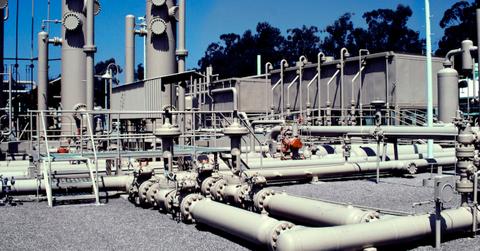A Look Into Natural Gas Extraction: Fracking, Horizontal, and Vertical Drilling
Published May 21 2021, 5:02 p.m. ET

It seems like everyone is talking about natural gas these days. Some are discussing its “redeeming qualities” in relation to other, more pollutive fossil fuels, but most discourse centers around how natural gas is extracted and how bad it is for the environment.
Getting natural gas out of the ground isn’t a matter of using a simple siphon — it’s a destructive, wasteful process, that often does more harm than good.

How is natural gas extracted?
Most people probably associate natural gas extraction with the process of fracking (hydraulic fracturing). However, fracking is only one facet of the process — there are two other common methods of natural gas extraction, including vertical drilling and horizontal drilling.
Vertical drilling is often the first method used in natural gas extraction.
When it comes to natural gas extraction, vertical drilling is often employed first. As explained by National Geographic, vertical drilling involves plunging a single vertical drill into the Earth’s surface, and pulling up whatever gas or oil is found in that particular gas well. Once those different levels of the substrate have been plunged along the vertical line, extraction companies move to the horizontal.
Horizontal drilling extends vertical drilling's range.
The next method employed is typically horizontal drilling, which covers gas and oil-rich areas along the substrates that were uncovered during the vertical drilling process.
According to NPR, horizontal drilling extends the 100-foot range of vertical drilling outwards for up to a mile or more. The drill moves through the previously identified vein of petroleum-rich shale and pulls from all along the longitudinal axis. Once the surface petroleum is tapped, fracking is employed.

If more gas needs to be extracted after that, it's time to start fracking.
Fracking involves taking that same vertical drill and shifting it horizontally to expand the amount of gas that can be pulled up from that well at any given level. This is achieved by splitting rock formations with a combination of highly pressurized water, chemicals, and sand. Fracking can result in toxic or radioactive wastewater, micro-earthquakes, groundwater contamination, explosions, and many more issues.
According to the Natural Resources Defense Council (NRDC), the fracking process requires an extensive array of drilling equipment. High-pressure, high-volume fracking pumps are used to push fluid into the rock. Blenders combine water, sand, and chemicals into the perfect fracking mix. This fracking fluid is about 97 percent water, with chemical additives and small solid “proppants” which are used to keep the fractures open after the initial drill.
Currently, fracking chemical blends are considered proprietary to the drilling companies that utilize them. That means that there’s no way for the public to know what goes into the ground to bring up the natural gas. All we know is that it creates wastewater, which is then stored in massive storage tanks to be dumped or disposed of elsewhere. At least, that’s what is supposed to happen.
The fracking process works as such:
Step 1: A long vertical or angled well is drilled and extended a mile or more into the earth until it nears the rock formation where the natural gas is trapped.
Step 2: Steel casings, or pipes, are inserted into the well and the space between the rock and casing is then filled with cement.
Step 3: Some wells are constructed with pre-perforated pipes, if not, a perforating tool makes small holes into the casing.
Step 4: High-pressure hoses pump fracking fluid into the casing. This creates new fractures in the surrounding rock, which allows the trapped oil or natural gas to float to the surface.
Step 5: The gas is collected, processed, and transported, while the wastewater is then moved to storage in nearby tanks or separate wells.
Wastewater tanks, hoses, and other equipment often have unforeseen cracks or leaks, which results in spillage and contamination of local habitats or municipal water supplies. It’s not a perfect system by any means, and human error, laziness, overused equipment, or unforeseen circumstances can turn an operation into an environmental disaster in an instant.

These dangers are why so many people are protesting against fracking. No matter how “clean” it might be relative to gasoline, natural gas is still a fossil fuel, and as long as we keep cutting environmental corners to extract it, the potential dangers it presents will always outweigh its scant virtues.